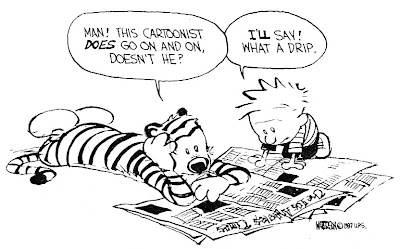
From the Cleveland Plain Dealer:
In today's cult of celebrity, it's a rare phenomenon: an artist who produces much-loved work, wins the hearts of fans and critics, and then abruptly retires and attempts to lead a normal, sometimes reclusive, life.
We're talking about the likes of Harper Lee, J.D. Salinger and "Calvin and Hobbes" comic strip creator Bill Watterson, who recently gave what's believed to be his first interview since 1989, to his hometown newspaper, The Cleveland Plain Dealer.
Watterson, now 51, crushed millions of funnies readers around the world in 1995 when he suddenly retired Calvin, a 6-year-old, philosophical version of Bart Simpson, and Hobbes, the stuffed tiger who comes to life in his imagination. Watterson has never really talked about it publicly, until now.
It turns out Watterson ended "Calvin and Hobbes" at the height of its popularity because he understands something the creators of long-running TV shows like "ER" and "The Simpsons" may not have.
"It's always better to leave the party early," Watterson writes in an e-mail Q&A with the Plain Dealer's John Campanelli. "If I had rolled along with the strip's popularity and repeated myself for another five, 10 or 20 years, the people now 'grieving' for "Calvin and Hobbes" would be wishing me dead and cursing newspapers for running tedious, ancient strips like mine instead of acquiring fresher, livelier talent. And I'd be agreeing with them."
He added, "I've never regretted stopping when I did."
Still, like many rock stars of the 1990s, Watterson waxes nostalgic about his celebrity. "Ah, the life of a newspaper cartoonist -- how I miss the groupies, drugs and trashed hotel rooms!" he joked.
But seriously -- in the 15 years since retiring from "Calvin and Hobbes," Watterson has been laying low in the Greater Cleveland area, no paparazzi in sight.
"The public attention has faded a lot. In pop culture time, the 1990s were eons ago," he said. "An artwork can stay frozen in time, but I stumble through the years like everyone else. I think the deeper fans understand that and are willing to give me some room to go on with my life."
Watterson may be kidding himself in that regard, as "Calvin and Hobbes" books continue to sell half a million copies a year, and recycled versions of the comic strip still run in 50 countries around the world, not including the U.S. Watterson long ago refused to license his characters, which means no animated TV specials or cuddly Hobbes toys, but fans will get a break this year when the U.S. Postal Service issues a "Calvin and Hobbes" stamp.
How soon will the reclusive Watterson actually use one to mail a letter?
"Immediately," he said. "I'm going to get in my horse and buggy and snail-mail a check for my newspaper subscription."
In today's cult of celebrity, it's a rare phenomenon: an artist who produces much-loved work, wins the hearts of fans and critics, and then abruptly retires and attempts to lead a normal, sometimes reclusive, life.
We're talking about the likes of Harper Lee, J.D. Salinger and "Calvin and Hobbes" comic strip creator Bill Watterson, who recently gave what's believed to be his first interview since 1989, to his hometown newspaper, The Cleveland Plain Dealer.
Watterson, now 51, crushed millions of funnies readers around the world in 1995 when he suddenly retired Calvin, a 6-year-old, philosophical version of Bart Simpson, and Hobbes, the stuffed tiger who comes to life in his imagination. Watterson has never really talked about it publicly, until now.
It turns out Watterson ended "Calvin and Hobbes" at the height of its popularity because he understands something the creators of long-running TV shows like "ER" and "The Simpsons" may not have.
"It's always better to leave the party early," Watterson writes in an e-mail Q&A with the Plain Dealer's John Campanelli. "If I had rolled along with the strip's popularity and repeated myself for another five, 10 or 20 years, the people now 'grieving' for "Calvin and Hobbes" would be wishing me dead and cursing newspapers for running tedious, ancient strips like mine instead of acquiring fresher, livelier talent. And I'd be agreeing with them."
He added, "I've never regretted stopping when I did."
Still, like many rock stars of the 1990s, Watterson waxes nostalgic about his celebrity. "Ah, the life of a newspaper cartoonist -- how I miss the groupies, drugs and trashed hotel rooms!" he joked.
But seriously -- in the 15 years since retiring from "Calvin and Hobbes," Watterson has been laying low in the Greater Cleveland area, no paparazzi in sight.
"The public attention has faded a lot. In pop culture time, the 1990s were eons ago," he said. "An artwork can stay frozen in time, but I stumble through the years like everyone else. I think the deeper fans understand that and are willing to give me some room to go on with my life."
Watterson may be kidding himself in that regard, as "Calvin and Hobbes" books continue to sell half a million copies a year, and recycled versions of the comic strip still run in 50 countries around the world, not including the U.S. Watterson long ago refused to license his characters, which means no animated TV specials or cuddly Hobbes toys, but fans will get a break this year when the U.S. Postal Service issues a "Calvin and Hobbes" stamp.
How soon will the reclusive Watterson actually use one to mail a letter?
"Immediately," he said. "I'm going to get in my horse and buggy and snail-mail a check for my newspaper subscription."
1 comment:
Well with no comments here I'll just add my own:
Watterson's Calvin and Hobbes much like Marlette's Kudzu was at the peak when it all came to a sudden end, one by choice and other by sad chance.
Sunday papers have never been the same since.
Post a Comment